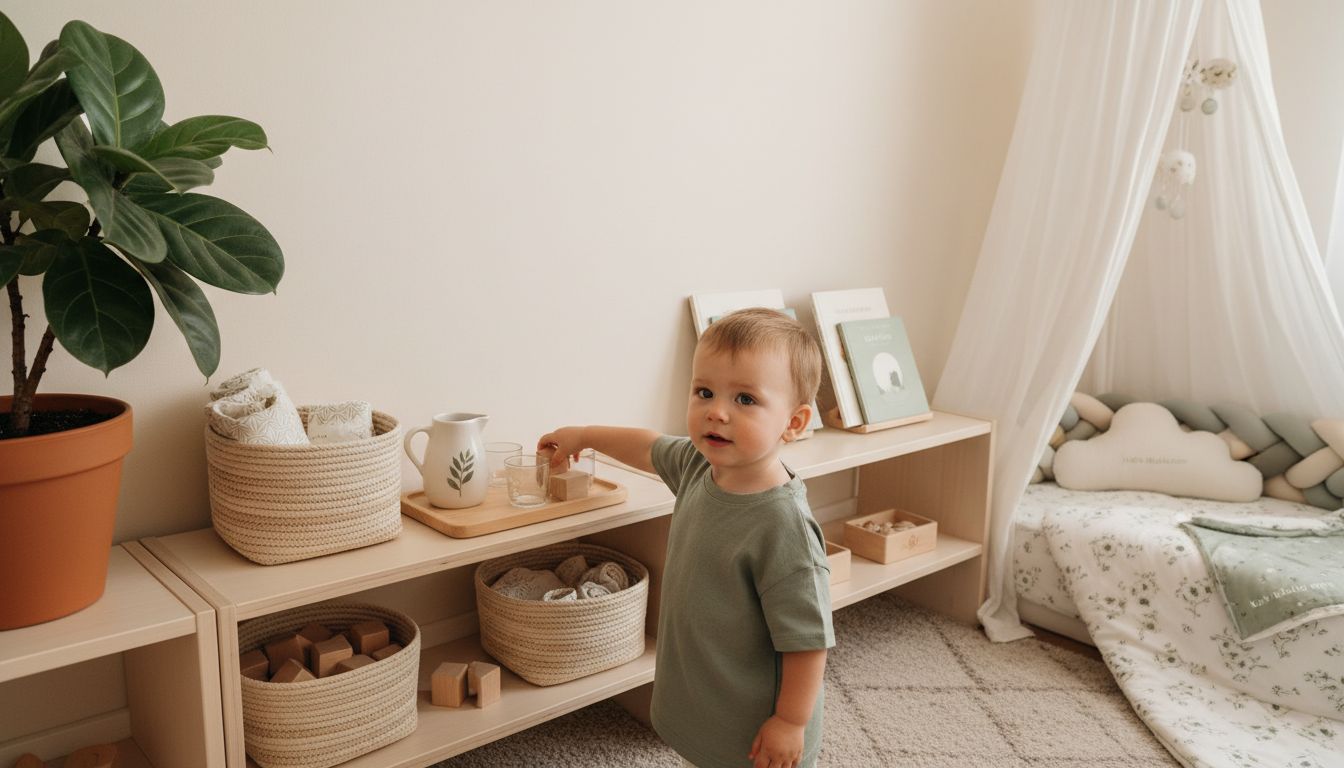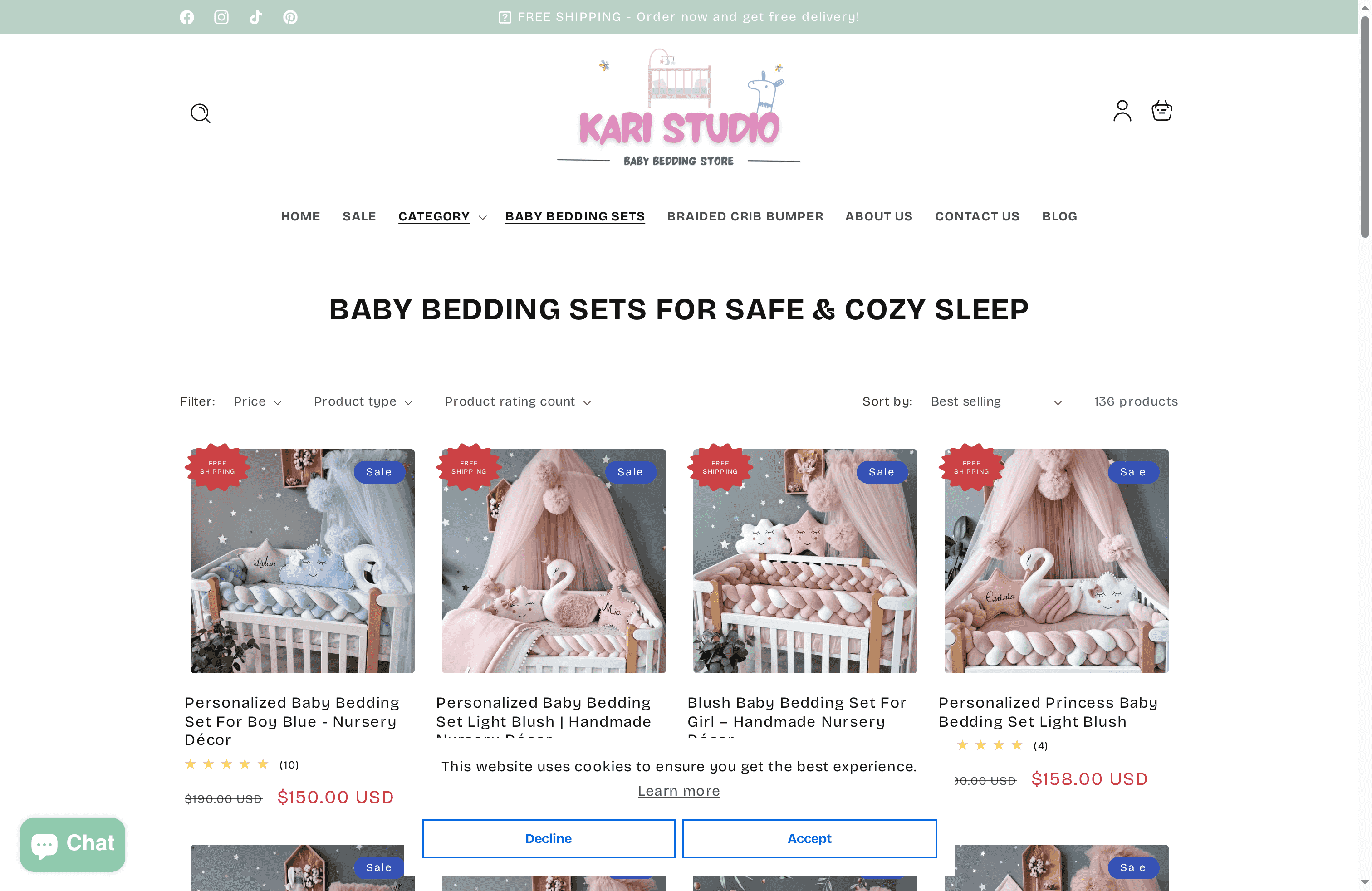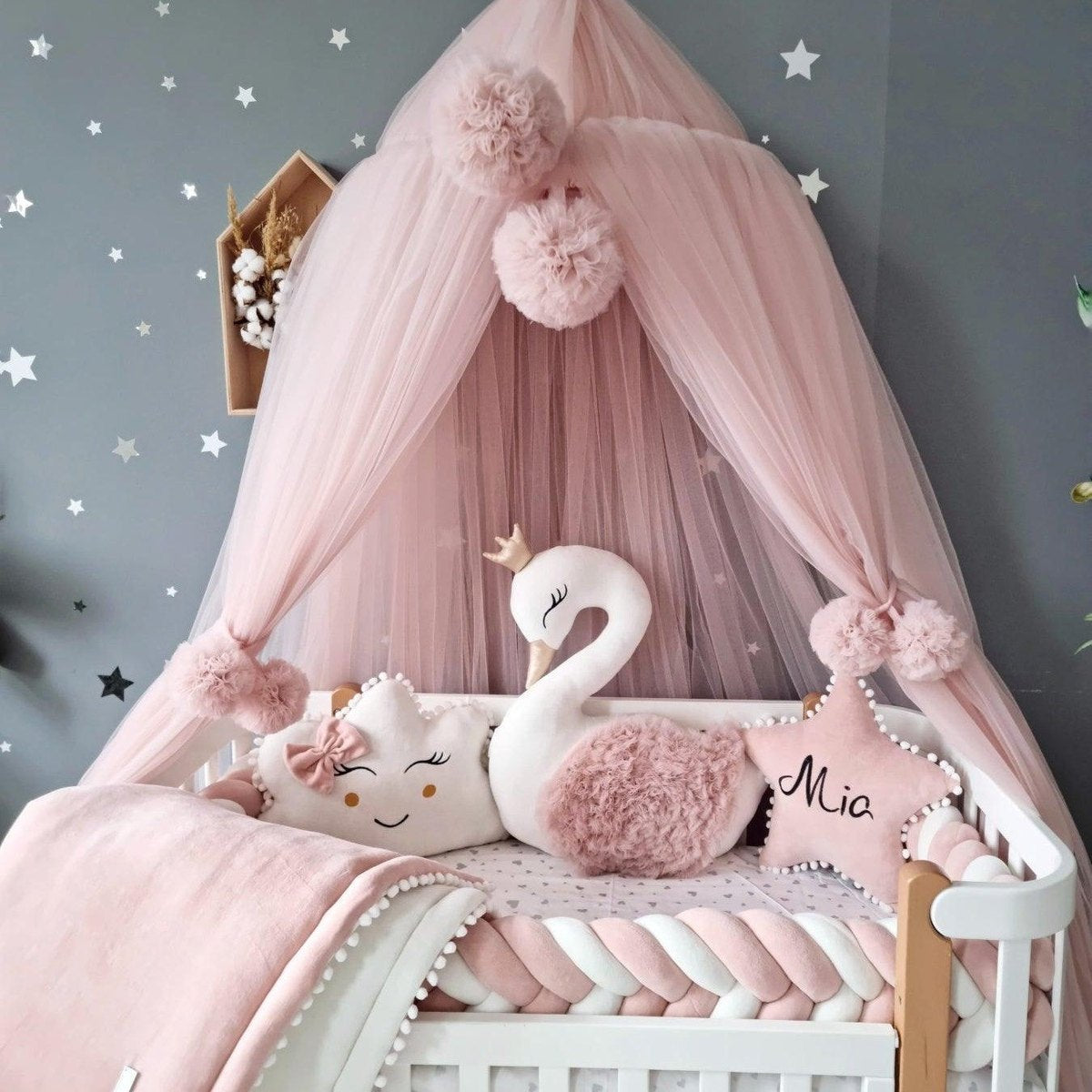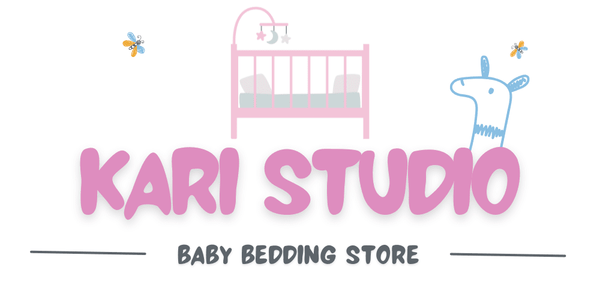Las guarderías Montessori están revolucionando la educación infantil temprana, con más de 20.000 escuelas Montessori que atienden a familias de todo el mundo. Este enfoque único se centra en brindar a los niños verdadera libertad, independencia y un sentido de orden desde el principio. Comprender los principios Montessori ayuda a los padres a crear espacios tranquilos e inspiradores donde los niños pueden aprender a su propio ritmo, desarrollar confianza y un verdadero amor por el descubrimiento.
Tabla de contenido
- Principios y filosofía de la guardería Montessori
- Elementos y diseño esenciales de una guardería Montessori
- Diferencias clave: Guarderías Montessori vs. Guarderías tradicionales
- Decoración Montessori: ropa de cama, almohadas y baldaquines
- Pasos para crear una guardería Montessori en casa
Conclusiones clave
| Punto | Detalles |
|---|---|
| Ambiente preparado | Las guarderías Montessori deben contar con espacios organizados que promuevan la exploración independiente y satisfagan las necesidades de desarrollo de los niños. |
| Aprendizaje dirigido por niños | Los niños prosperan en entornos que les permiten elegir sus actividades y aprender a su propio ritmo, fomentando la motivación intrínseca. |
| Diseño con propósito | Utilice muebles de tamaño infantil y estantes bajos y accesibles para crear zonas de aprendizaje designadas que fomenten la autonomía y la participación. |
| Materiales naturales | Incorpore materiales naturales y una paleta de colores neutros en la decoración para crear una atmósfera tranquila que fomente la exploración sensorial y la independencia. |
Principios y filosofía de la guardería Montessori
El método Montessori representa un enfoque revolucionario para el desarrollo infantil temprano que transforma nuestra percepción del aprendizaje y la independencia. Desarrollada por la Dra. María Montessori, esta filosofía educativa se centra en empoderar a los niños para que exploren y aprendan a través de entornos cuidadosamente diseñados que respetan sus etapas naturales de desarrollo.
Según AMI USA , el enfoque Montessori se basa fundamentalmente en varios principios básicos que lo distinguen de los modelos educativos tradicionales:
- Entorno preparado : un espacio cuidadosamente organizado y diseñado para facilitar la exploración independiente.
- Mente Absorbente : Reconocimiento de que los niños absorben naturalmente el conocimiento de su entorno.
- Períodos sensibles : comprender que los niños tienen períodos de desarrollo específicos para aprender ciertas habilidades.
- Libertad dentro de límites : permitir la autonomía de los niños al tiempo que se les proporciona orientación estructurada
En una guardería Montessori , cada elemento se selecciona intencionalmente para fomentar la curiosidad innata del niño y su aprendizaje autónomo. Montessori.org explica que estos entornos están meticulosamente organizados en áreas curriculares, con materiales de aprendizaje estratégicamente dispuestos en estantes abiertos para fomentar la exploración natural y fomentar el orden.
El objetivo principal de esta filosofía no es solo el aprendizaje académico, sino el desarrollo integral. Al crear espacios que invitan al descubrimiento, respetan el ritmo del niño y ofrecen desafíos apropiados para su edad, las guarderías Montessori ayudan a los niños a desarrollar confianza, habilidades para la resolución de problemas y un amor intrínseco por el aprendizaje. Este enfoque considera la educación como un proceso colaborativo donde los niños son participantes activos, no receptores pasivos de información.
Para los padres que estén considerando una habitación infantil inspirada en Montessori, la clave está en crear un ambiente que equilibre la estructura con la libertad. Estanterías bajas y accesibles, muebles a medida para niños y materiales educativos cuidadosamente seleccionados pueden transformar una habitación sencilla en un entorno de aprendizaje enriquecedor que crece con las etapas de desarrollo de su hijo. Consulte nuestra guía de diseño minimalista para habitaciones infantiles para obtener consejos prácticos de implementación que se alinean con los principios Montessori.
Elementos y diseño esenciales de una guardería Montessori
Crear una habitación infantil inspirada en el método Montessori va más allá de las decisiones estéticas: se trata de diseñar un espacio con un propósito que fomente el desarrollo natural y la independencia de tu hijo. Cada elemento de la habitación debe seleccionarse cuidadosamente para fomentar la exploración, el aprendizaje y el juego autónomo.
Montessori.org enfatiza que un verdadero entorno Montessori está meticulosamente organizado en áreas de aprendizaje específicas, con materiales estratégicamente dispuestos para maximizar la participación. Los elementos clave del diseño incluyen:
- Estanterías bajas y abiertas : permiten que los niños accedan y devuelvan los materiales de forma independiente.
- Muebles a medida para niños : Permiten el movimiento y la autosuficiencia.
- Materiales naturales : juguetes de madera, telas de algodón y objetos del mundo real.
- Desorden mínimo : crea un ambiente tranquilo y concentrado
- Paleta de colores neutros : reduce la sobreestimulación visual
La distribución física de una guardería Montessori es intencionadamente minimalista y estructurada. Cada área debe tener un propósito específico, ya sea un rincón de lectura, una zona de arte o una zona de habilidades prácticas para la vida. Los materiales se seleccionan cuidadosamente para adaptarse a la etapa de desarrollo actual del niño, fomentando el dominio y desarrollando la confianza mediante la exploración independiente.

Los padres pueden empezar a implementar los principios Montessori creando espacios específicos que inviten a la interacción. Un espejo bajo para el autodescubrimiento, una cama de suelo que permita la libertad de movimiento y soluciones de almacenamiento abiertas que faciliten el acceso a los juguetes y materiales de aprendizaje son fundamentales. Explora nuestras ideas de decoración para la habitación del bebé y descubre cómo integrar a la perfección estos conceptos de diseño en un espacio bonito y funcional que se adapte al crecimiento de tu hijo.
Diferencias clave: Guarderías Montessori vs. Guarderías tradicionales
El enfoque de la educación infantil temprana puede influir significativamente en la experiencia de aprendizaje de un niño, y las diferencias entre Montessori y las guarderías tradicionales son profundas y de gran alcance. Mientras que las guarderías tradicionales suelen seguir un modelo universal, los entornos Montessori están diseñados para fomentar los estilos de aprendizaje y las trayectorias de desarrollo individuales.
Montessori.org destaca una distinción crucial: en las aulas Montessori, los niños tienen la capacidad de elegir sus actividades y trabajar a su propio ritmo, lo que desafía fundamentalmente el modelo tradicional de aprendizaje dirigido por el profesor. Esta diferencia fundamental se manifiesta en varias áreas clave:
Análisis comparativo:
-
Enfoque de aprendizaje
- Montessori: aprendizaje autodirigido y dirigido por el niño
- Tradicional: currículo estandarizado y dirigido por el docente
-
Ambiente del aula
- Montessori: Espacios abiertos, flexibles y con materiales accesibles
- Tradicional: Asientos estructurados y uniformes con instrucción centralizada
-
Interacción estudiantil
- Montessori: Grupos de edades mixtas, aprendizaje colaborativo
- Tradicional: Modelo de aprendizaje competitivo y segregado por edad
Los fundamentos filosóficos de estos enfoques crean experiencias de aprendizaje fundamentalmente diferentes. La educación Montessori considera al niño como alguien con un deseo natural de aprender, con una capacidad innata para autoeducarse cuando se le proporciona el entorno adecuado.
Las guarderías tradicionales, por el contrario, a menudo ven a los niños como receptores pasivos de conocimiento que deben ser guiados estrictamente por la instrucción de los adultos.
Esto no significa que un enfoque sea universalmente superior; cada uno tiene sus ventajas. Sin embargo, para los padres que buscan un modelo educativo que fomente la motivación intrínseca, la independencia y el auténtico amor por el aprendizaje, el método Montessori ofrece una alternativa atractiva. Explore nuestras tendencias en guarderías para 2025 y descubra cómo el diseño moderno adopta cada vez más los principios de aprendizaje centrados en el niño.
Decoración Montessori: ropa de cama, almohadas y baldaquines
Diseñar una habitación infantil inspirada en Montessori va más allá de la distribución de los muebles: se trata de crear un ambiente considerado que favorezca el desarrollo natural de tu hijo mediante elementos decorativos cuidadosamente seleccionados. Cada textil y accesorio debe promover la independencia, la comodidad y la exploración sensorial, manteniendo una estética limpia y despejada.
Montessori.org enfatiza la importancia de crear espacios que fomenten la exploración y el orden, un principio que se aplica directamente a la decoración de la habitación infantil. La ropa de cama y los accesorios Montessori deben incorporar estas características clave:
Principios de selección de decoración:
- Materiales naturales : Priorizar el algodón, el lino y la lana.
- Paleta de colores neutros : tonos suaves y apagados que no sobreestimulan
- Diseños simples : patrones minimalistas, líneas limpias.
- Estética funcional : cada artículo cumple una función de desarrollo.
Al seleccionar la ropa de cama y los accesorios, concéntrese en artículos que favorezcan la creciente independencia de su hijo. Una cama baja con ropa de cama transpirable y ligera permite libertad de movimiento. Las almohadas deben ser mínimas y estar estratégicamente ubicadas para fomentar la exploración segura. Los doseles pueden crear una sensación de espacio personal a la vez que mantienen un ambiente abierto y acogedor.
Para los padres que buscan crear un espacio de descanso perfecto inspirado en Montessori, la elección de accesorios es clave. Descubra cómo usar cortinas con dosel para transformar la habitación de su bebé y crear un ambiente acogedor que se adapte a sus necesidades de desarrollo.
Pasos para crear una guardería Montessori en casa
Transformar la habitación de tu hijo en un espacio inspirado en Montessori es un proceso meticuloso que busca crear un entorno que fomente la curiosidad natural de tu hijo y promueva su aprendizaje independiente. El objetivo no es la perfección, sino crear un espacio con propósito que apoye su desarrollo.
Montessori.org enfatiza el diseño de un entorno preparado con áreas curriculares cuidadosamente organizadas. Aquí tienes un enfoque paso a paso para crear una auténtica guardería Montessori:
Pasos para la implementación de una guardería Montessori:
-
Despeja y simplifica
- Retire el exceso de muebles
- Crear espacios abiertos y accesibles
- Elija piezas minimalistas y funcionales
-
Seleccione muebles pensados para los niños
- Estantes bajos y accesibles
- Cama de suelo en lugar de cuna tradicional
- Sillas y mesas de tamaño infantil
-
Crear zonas de aprendizaje
- Designar áreas específicas para diferentes actividades
- Organice los materiales para facilitar el acceso
- Utilice paletas de colores naturales y neutros.
La clave es crear un ambiente que invite a la exploración, manteniendo al mismo tiempo un ambiente de orden y calma. Cada objeto debe tener una función específica, animando a tu hijo a participar de forma independiente y a desarrollar habilidades esenciales para la vida. Materiales naturales, texturas suaves y herramientas de aprendizaje cuidadosamente seleccionadas transformarán la habitación de tu hijo en un paraíso para el desarrollo.
Descubra ideas de decoración de guardería DIY que pueden ayudarlo a personalizar su espacio inspirado en Montessori, haciéndolo funcional y hermoso para su pequeño explorador en crecimiento.
Cree una guardería Montessori que realmente apoye el crecimiento de su hijo
Diseñar una habitación infantil Montessori implica crear un espacio que fomente la independencia, la exploración y la concentración. El reto al que se enfrentan muchos padres es encontrar artículos esenciales que reflejen estos valores sin sacrificar la comodidad ni la seguridad. Conceptos clave de Montessori, como el "ambiente preparado" y la "libertad dentro de ciertos límites", exigen artículos cuidadosamente seleccionados y accesibles que se adapten al crecimiento del niño.
En Kari Studio, entendemos la importancia de crear una habitación infantil que respete el desarrollo de tu pequeño. Nuestros artículos esenciales para la habitación, hechos a mano, incluyen juegos de cama premium , protectores de cuna trenzados y doseles, y están confeccionados con telas hipoalergénicas y suaves para crear un ambiente acogedor y seguro. Cada pieza está cuidadosamente diseñada para combinar funcionalidad con belleza natural y se puede personalizar para reflejar tu estilo único.

Dale vida a la filosofía Montessori en tu hogar hoy mismo explorando nuestra colección de artículos esenciales para la habitación del bebé, que hacen que la exploración independiente sea segura y cómoda. Empieza a crear el espacio perfecto para tu hijo en Kari Studio y descubre cómo los diseños personalizados para la habitación del bebé pueden fomentar su crecimiento con cada detalle. Explora nuestros juegos de cama personalizados para bebé y encuentra el complemento perfecto para tu habitación de inspiración Montessori.
Preguntas frecuentes
¿Cuáles son los principios básicos de una guardería Montessori?
Los principios básicos de una guardería Montessori incluyen un entorno preparado que apoya la exploración independiente, el reconocimiento de la mente absorbente de los niños, la comprensión de los períodos sensibles para la adquisición de habilidades y la libertad dentro de límites para fomentar la autonomía manteniendo una guía estructurada.
¿En qué se diferencian las guarderías Montessori de las guarderías tradicionales?
Las guarderías Montessori priorizan el aprendizaje guiado por el niño y la exploración autónoma, mientras que las guarderías tradicionales suelen seguir un currículo estandarizado y dirigido por el docente. Los entornos Montessori están diseñados con espacios abiertos y materiales accesibles, lo que promueve el aprendizaje colaborativo en lugar de la dinámica competitiva propia de los entornos tradicionales.

¿Cuáles son los elementos de diseño esenciales para una guardería Montessori?
Los elementos de diseño clave para una guardería Montessori incluyen estantes bajos y abiertos para mayor accesibilidad, muebles de tamaño infantil para promover la independencia, materiales naturales para juguetes y decoración, un desorden mínimo para crear una atmósfera tranquila y una paleta de colores neutros para reducir la sobreestimulación.
¿Cómo puedo empezar a implementar los principios Montessori en casa?
Para implementar los principios Montessori en casa, comience por ordenar y simplificar el espacio, seleccionando muebles centrados en el niño, como estantes bajos y camas de piso, y creando zonas de aprendizaje designadas que inviten a la exploración mientras mantienen una sensación de orden y calma.
Recomendado
- 7 consejos esenciales para un diseño minimalista de habitación infantil – KariStudio
- Consejos esenciales para padres primerizos
- 7 tendencias clave para guarderías infantiles en 2025: información esencial para padres
- Artículos - KariStudio
- Guía completa del juego Montessori en el Reino Unido – Learning Bugs

